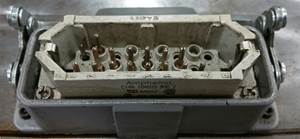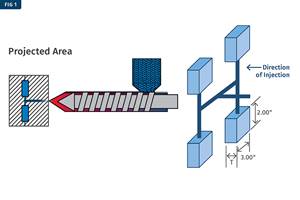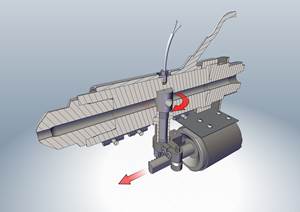AC Variable-Speed Drives Raise Molding Productivity
A more economical approach than either all-electric servo drives or special hydraulic pump packages is offered by Magnum LLC, Garden Grove, Calif. It is one of several firms that retrofit AC induction pump motors with variable-speed drive systems in place of the usual fixed-speed pump motor.
Standard hydraulic injection presses cannot overlap process steps such as screw recovery and mold clamping/unclamping. In contrast, all-electric and hybrid-electric machines can overlap machine functions as a means to shorten cycle times. Users of hydraulic presses have the option of adding a special pump package to confer the capability for overlapping process steps, but it is very expensive.
A more economical approach than either all-electric servo drives or special hydraulic pump packages is offered by Magnum LLC, Garden Grove, Calif. It is one of several firms that retrofit AC induction pump motors with variable-speed drive systems in place of the usual fixed-speed pump motor. Magnum uses off-the-shelf drives from Toshiba or Yaskawa of Japan. Magnum has provided this service for the past decade, but the devices were used primarily to save energy costs. Those savings arise because the variable-speed pump motor slows during parts of the molding cycle when the process requires little or no oil flow. A normal fixed-speed drive wastefully keeps pumping oil over a relief valve and back to tank during idle periods.
Says company co-owner Pat Mulligan, "Firms buying Magnum's system have been aware of the energy savings for years, but they are just now finding out about the ability of the drives to increase productivity by shortening cycle times. Energy savings can be from 50% to as high as 80%. Productivity can be enhanced by 15-20%."
A number of custom molders and Tier One automotive parts suppliers say such productivity improvements have allowed them to take on molding jobs that they could not have performed cost-competitively with a standard machine. Steve Dowling, v.p. of operations at custom molder Universal Plastic Molding (UPM) Inc. in Baldwin Park, Calif., explains that the ability to overlap screw return with clamp movements benefits jobs with short cycle times the most. It's just the opposite with energy savings: "The longer the initial cycle time, the greater the time savings," says Dowling.
Mulligan says variable-speed drives can benefit processes with cycle times as short as 10 sec. The variable-speed drive can raise the rpm of the motor above its rated capacity for short periods when maximum oil flow is required. Mulligan says the brief burst of higher speed "doesn't put any stress on the motor at all, but delivers a higher volume of oil at a higher velocity."
In high-speed molding applications, the Magnum system improves productivity by 13-22% for some customers. Custom molder JSN of Irvine, Calif., ran a 14-oz shot on a 385-ton JSW press and reduced the normal 16.8-sec cycle time by 3.7 sec, or 22%, with the Magnum drive system, says JSN v.p. Joe LaLonde.
Multiple savings
A hydraulic press has several pump motors and drives to deliver oil for particular process functions. A particular motor and pump unit will be activated at certain points in the process. Magnum evaluates an existing machine to determine whether and how a variable-speed drive could provide benefits. "We let the operator set up the machine, then we take power readings to determine what each motor in the hydraulic system does during the molding cycle," Mulligan explains. "Magnum has a program that calculates what the optimum motor speed needs to be for a particular operation, and what size is needed." The variable-speed drive controls are piggybacked on the existing machine-control system, and operate automatically when the machine is in use. The system also has a bypass button if there is a problem with the variable-speed drive. The drive system accelerates from zero to 100% torque in 0.1 sec for fast and repeatable response, says Magnum co-owner Dave Sandy. "The system can deliver oil with 0.1% accuracy. Electronic control of the hydraulic system helps to reduce scrap generation," Sandy adds.
Machine maintenance may also be less with the variable-speed drive. "The valves within the hydraulic system are always left completely open because the drive is controlling the motor and the flow of oil through the system. This open position of the valves eliminates the stress on seals, valves, and hoses when valves open and close during standard molding," says Sandy. He adds that keeping the valves wide open allows the oil to move more quickly and keeps it 10-12° F cooler, since the oil is not sheared by being forced through small valve apertures.
Custom molders say there is a short learning curve to using variable speed drives. These drives can be retrofitted to any machine size (they can control motors of up to 250 hp). Price of a variable-speed drive system is in the range of $10,000 for a 60-hp motor.
A molder's testimony
UPM has 25 machines, mostly Milacron and JSW, ranging from 300 to 2000 tons. It has variable-speed drives on all but five units, and those others will be upgraded soon. Dowling says screw-recovery time was the most important factor limiting UPM's molding productivity. Mold and clamp movements could not commence until the screw finished plasticating. The firm used a Magnum variable-speed drive system to solve the problem of molding a large polypropylene crate on a 700-ton press. "It would have cost around $100,000 to add a special pump package to our hydraulic machine," he says. "With the Magnum unit installed, we got our cycles down to 36 sec from 40, and raised production from 90 shots to 100 shots an hour," says Dowling.
He adds, "We have a client who is a major supplier of housewares. When their machines are fully utilized, they sometimes ask us to run product for them. Because their machines are custom designed for a job, they have functions like independent screw return that let them run at shorter cycles. I couldn't get the ´óĎó´«Ă˝ with a standard machine, so I have to have the ability to run shorter cycles, too." Variable-speed drives were the only cost-effective answer. "It's not worth it to buy a special pump package just to get someone's overflow ´óĎó´«Ă˝," Dowling states.
Related Content
Hot Runners: How to Maintain Heaters, Thermocouples, and Controls
I conclude this three-part examination of real-world problems and solutions involving hot runners by focusing on heaters, thermocouples, and controls. Part 3 of 3.
Read MoreProcess Monitoring or Production Monitoring — Why Not Both?
Molders looking to both monitor an injection molding process effectively and manage production can definitely do both with tools available today, but the question is how best to tackle these twin challenges.
Read MoreIs There a More Accurate Means to Calculate Tonnage?
Molders have long used the projected area of the parts and runner to guesstimate how much tonnage is required to mold a part without flash, but there’s a more precise methodology.
Read MoreKnow Your Options in Injection Machine Nozzles
Improvements in nozzle design in recent years overcome some of the limitations of previous filter, mixing, and shut-off nozzles.
Read MoreRead Next
For PLASTICS' CEO Seaholm, NPE to Shine Light on Sustainability Successes
With advocacy, communication and sustainability as three main pillars, Seaholm leads a trade association to NPE that ‘is more active today than we have ever been.’
Read MoreLead the Conversation, Change the Conversation
Coverage of single-use plastics can be both misleading and demoralizing. Here are 10 tips for changing the perception of the plastics industry at your company and in your community.
Read MoreMaking the Circular Economy a Reality
Driven by brand owner demands and new worldwide legislation, the entire supply chain is working toward the shift to circularity, with some evidence the circular economy has already begun.
Read More











